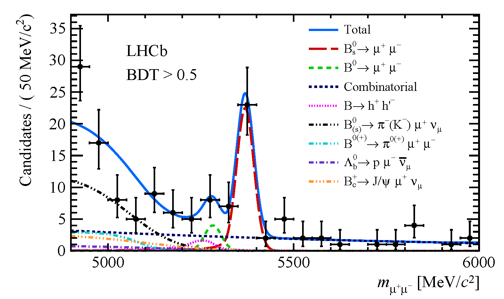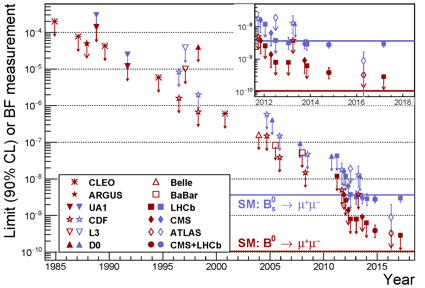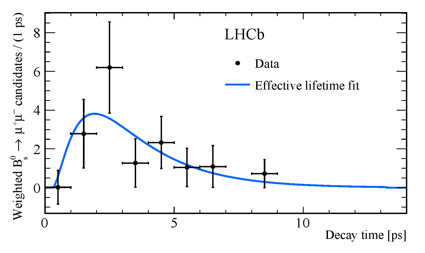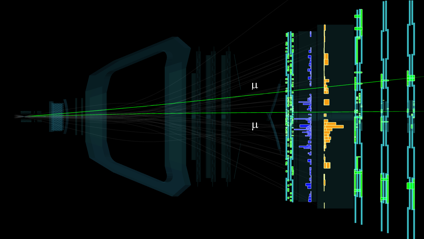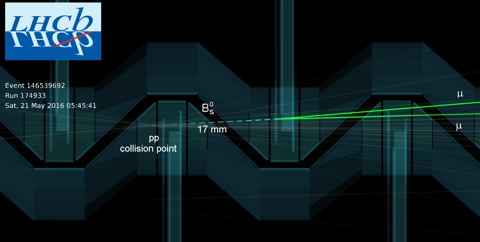From discovery to precision measurement.
[ Branching fraction Bs0→ μ+μ– = (3.0±0.6+0.3-0.2)x10-9 ; B0→ μ+μ– < 3.4×10-10 ]
Today, in a seminar at CERN, the LHCb collaboration presented the first observation by a single experiment of the decay Bs0→μ+μ–, with a statistical significance of 7.8 standard deviations. The measured branching fraction (3.0±0.6+0.3-0.2)x10-9 is in agreement with the Standard Model (SM) prediction of (3.65±0.23)x10-9. It is the most precise measurement of this quantity to date.
The full 3 fb-1 of data collected during Run 1, and 1.4 fb-1 of data accumulated during Run 2 were used to obtain this result. A special event selection (BDT for experts) was used to classify data into bins with different ratios of Bs0→ μ+μ– decays and background contributions. The μ+μ– invariant mass spectrum for the bins with the smallest background contribution (BDT>0.5) is shown in the image. The contribution of the Bs0→ μ+μ– decay is clearly visible at the Bs0 mass and is indicated as the red peaking distribution. The green peaking distribution shows a possible contribution of the B0→ μ+μ– decay at lower mass, which is expected in the SM at a rate of about 30 times smaller. The size of this contribution is not found to be significant, and so an upper limit is set for the decay at a value of 3.4×10-10. The other contributions show the contribution of background processes. They provide very little contamination in the region of the Bs0→ μ+μ– signal.
The probability, or branching fraction, of the Bs0 meson to decay into two oppositely charged muons is very small in the SM and is well predicted. On the other hand, a large class of theories that extend the SM, such as, for example, supersymmetry, allows significant modifications to this branching fraction and therefore an observation of any significant deviation from the SM prediction would indicate a discovery of new effects. The decay of a Bs0 meson into a muon pair has therefore long been regarded as one of the most promising places to search for these new effects. This decay has been searched for more than 30 years by different experiments at different accelerators as shown in the image. The LHCb collaboration obtained the first evidence, with a significance of 3.5 standard deviations, in November 2012 and, together with the CMS collaboration, the first observation, with a significance of 6.2 standard deviations, in May 2015. Previous results already severely constrained the type of SM-extension models that are still allowed, as described, for example, in the 30 March 2012 news. The results announced today isolate even more precisely the parameter region in which these new models can exist, and therefore focuses future experimental searches and theoretical attention. All candidate models of physics beyond the Standard Model will have to demonstrate their compatibility with this important result.
Some new-physics models also allow the possibility of a different Bs0 “effective” lifetime from what is predicted in the SM. LHCb also reported today the first measurement of this quantity, and found it to be 2.04±0.44±0.05 ps in agreement with the SM prediction. The left image shows the characteristic exponential decay time distribution of Bs0→ μ+μ– decay events.
A typical Bs0→ μ+μ– decay candidate event recorded in 2016 is shown below. The two muon tracks from the Bs0 decay are seen as a pair of green tracks traversing the whole detector in the left image. The right image shows the zoom around the proton-proton collision point, the origin of many particle tracks. The two muon green tracks originate from the B0s decay point located 17 mm from the proton-proton collision. You can play with images of 3 new Bs0→ μ+μ– decay candidates recorded during the 2016 data taking period using the LHCb 3D event display. This web based event display will run on your computer or smartphone without need to load any specialized software.
LHCb looks forward to making even more precise measurements of the Bs0 branching ratio, continuing its search for the B0→μ+μ– decay, and improving the knowledge of the effective lifetime. Stay tuned for updates from Run 2 data.
Click the images for higher resolution. More details can be found in the LHCb presentation at CERN and in the LHCb publication. Read more in the CERN update for the public both in English and in French, in the Symmetry magazine and in the CERN Courier article. The preliminary numbers and plots presented at the seminar have been replaced with the final ones on March 11.

